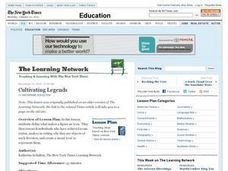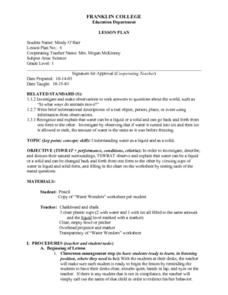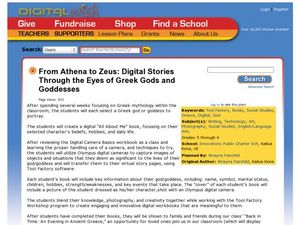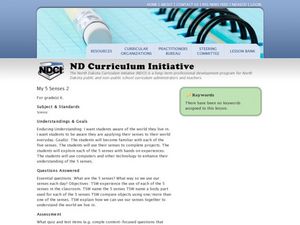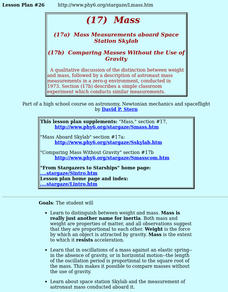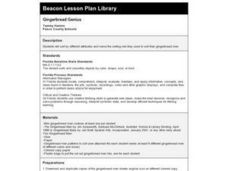Curated OER
20 Questions: Can You Stump the Machine?
Students use technology to help them think critically. They collect data related to the tool, which asks 20 questions. They discuss how the technology in the machine makes it work.
Curated OER
Cultivating Legends
Students research individuals considered to be icons. After reading an article about Sylvia Plath, they create written analyses about them along with visual representations. Students discover the differences between icons and heroes.
Curated OER
Heat Misconceptions
Third graders determine that gloves do not provide heat, but rather, they insulate or hold in any heat that is in their hand. They discuss the different temperatures found in ecosystems around the world. What do animals that live in...
Curated OER
Zelda and Ivy
Second graders read the theme books Zelda and Ivy and do activities that are related to the books. In this reading lesson, 2nd graders read the books given and then do activities that include a reader's theater, crossword, personality...
Curated OER
Misused Verbs: Lie/Lay
In this misused verbs worksheet, students insert the words lie or lay into the sentences. Students complete 10 sentences total on this worksheet.
Curated OER
"Creating Movement through Literature" Dance Lesson Plan
Students listen to a story and then use the words from the book to generate dance movements.
Curated OER
Water - Solid and Liquid
First graders conduct a science inquiry by comparing water in its liquid and solid form. The students describe the different stages of water and complete a worksheet answering questions about each form of the water. Teacher assessment...
Curated OER
Scientific Methods and Inquiry Skills
Fifth graders conduct a mystery bag experiment and use the scientific method and inquiry skills to solve the mystery. They discuss how to make scientific "guesses," and in small groups use their five senses to try and figure out what...
Curated OER
Recyclers to the Rescue
Fifth graders examine the concept of the food chain and define producer, consumer, herbivore, carnivore, and omnivore. They draw a food chain for a mouse and discuss the different organisms involved in the chain, and conduct an...
Curated OER
Family Letter and Activity: Cars, Trucks and Percents
In this math instructional activity, students will take home a letter to their parents explaining that they are studying Chapter 10: Ratio, Proportion and Percent. Then students will complete a homework activity in which they ask family...
Curated OER
Biography and Portraiture
Students determine the relationship between biography and portraiture. In this biography and portraiture lesson, students decide upon the differences and similarities between biography and portraits and whether or not biographical...
Curated OER
From Athena to Zeus: Digital Stories Through the Eyes of Greek Gods and Godesses
Practice creating digital presentations based around Greek Mythology. Your class will create digital books dedicated to individual Greek Gods. They will utilize their photography skills and multimedia labs to create a digital experience...
Curated OER
My Five Senses 2
Students investigate the five senses. In this five senses lesson, students answer essential questions about the use of the five senses as they interact with their environment. They use a computer software program to make a concept web...
Curated OER
Mass
High schoolers participate in a qualitative discussion of the distinction between weight and mass, followed by a description of astronaut mass measurements in a zero-g environment.
Curated OER
Cloud Watchers
Second graders read "The Cloud Book" by Tomie dePaola to jumpstart their cloud study. They offer examples of liquids, solids, and gases and chart them. They observe the making of a cloud in a demonstration. They discuss and draw...
Curated OER
Gingerbread Genius
Students sort gingerbread men, then identify the sorting rule that they used.
Curated OER
Be a Geography Observor and Recorder
Young scholars investigate the human and physical features of their school neighborhood. They observe the physical and man made features outside, make illustrations of their observations, and develop a class list of their observations.
Curated OER
Fractions
Fourth graders define and identify fractions. They draw a fraction with the correct number of equal parts, shade a specified number of parts, and write a fraction based on information from a variety of story problems. Students observe...
Curated OER
Measuring in Inches
First graders discover that there are two types of standard measurement using a ruler: centimeters and inches. They use the inches side to measure pipe cleaner "worms"; straigthening them out and laying them on the end of the ruler with...
Curated OER
Earth Composition and Plate Tectonics
Students investigate the composition of the interior of the Earth through a teacher lead instructional activity. They study the theory of plate tectonics before creating a model of the earth's interior. They use a hard boiled egg to...
Curated OER
Capitalization
Fourth graders identify and use the rules and guidelines for capitalization when seen in print. They complete a written or oral assessment of capitalization rules. A comprehensive rubric is included for determination of mastery.
Curated OER
Simple Simon Went A-Fishing
Young scholars investigate the concept of reading a story with the help of the teacher to pronounce words with the singing of a song that is used to stimulate memory. They read the story while singing and review which words are rhyming.
Curated OER
Past Time: Vocabulary Practice Worksheet 3
In this vocabulary practice worksheet, learners choose the best word from 2 possible choices to complete each of 12 sentences. Despite the title, the sentences have little to do with past time.
Curated OER
World Map and Globe - Lesson 1 Introduction to the Globe
Students explore the earth with maps and globes. For this map lesson, students use maps and globes to locate oceans and continents.



